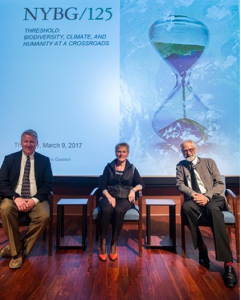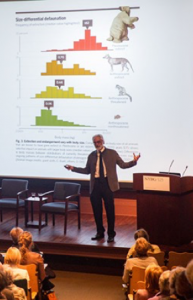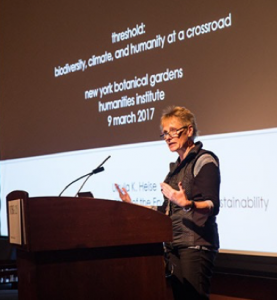Threshold: Biodiversity, Climate, and Humanity at a Crossroads
Posted in From the Library, Humanities Institute on May 31 2017, by Vanessa Sellers

On March 9, the Humanities Institute’s Fourth Annual Symposium was held at the Garden, offering a vital discussion among three renowned experts, and the larger public, on biodiversity and nature conservation in the era of climate change. Convened by the Humanities Institute and the Center for Science and Society, as well as History Initiative at Columbia University, this symposium served as a critical introduction to key issues about modern society and its relationship with the environment.
Challenging issues such as the possibility of future life on Earth, participants were invited to ask themselves the following questions: What does biodiversity mean in the broader context of 21st-century environmental politics and ethics and in the specific case of the 2016 Paris Agreement? Is there a common, sustainable future possible in this new period of American isolationism, when Washington threatens to pull out of global environmental treaties, such as the 2016 Paris Agreement? What are the most urgent eco-political and ethical laws that need enforcing to ascertain the availability of the world’s natural resources to tomorrow’s generation? Challenging questions that need expert knowledge and guidance.

The Garden was particularly fortunate to be able to welcome Professor Shahid Naeem of the Earth Institute at Columbia University, whose research under the motto of “ecology without apology” has laid many of the foundations for thinking about biodiversity and conservation, as his presentation “Sustainability in an Age of Mass Extinction and Isolationism” clearly showed. Shahid Naeem’s message was straightforward and sobering: we find ourselves in the ‘sixth extinction,’ as is clearly confirmed by scientific graphs, and half of the world’s species could disappear in the next few decades.
Professor Ursula Heise, the Marcia H. Howard Chair in Literary Studies at the Department of English and the Institute of the Environment and Sustainability at UCLA, added intriguing visions about post-human landscapes in her contribution: “Where the Wild Things Used To Be: Narrative, Biodiversity, and Dystopia.”

A high point was her in-depth analysis of an advertisement by Nissan featuring a polar bear who decides to leave the North Pole and live a suburban life.
Professor John Nagle, the John N. Mathews Chair at the Notre Dame Law School, in his talk, “The Inimitable Endangered Species Act,” compared historical and current eco-legislation, focusing on the Endangered Species Act of 1973, signed into law by President Richard Nixon, with the famous words: “Nothing is more priceless and more worthy of preservation than the rich array of animal life with which our country has been blessed.”
In spite of the law’s limitations, all animals and plants that were listed have not gone extinct; a remarkable accomplishment. All three presentations showed the fundamental importance of the way that biodiversity, endangered landscapes, and species are represented and addressed in literature, law, and a variety of other disciplines in academia and beyond. Together, and in conversation with the wider NYBG audience, the three speakers highlighted serious shortcomings as well as promising solutions for several of the most pressing questions of our modern age.

The proceedings of the Threshold Symposium are accessible online via YouTube.

